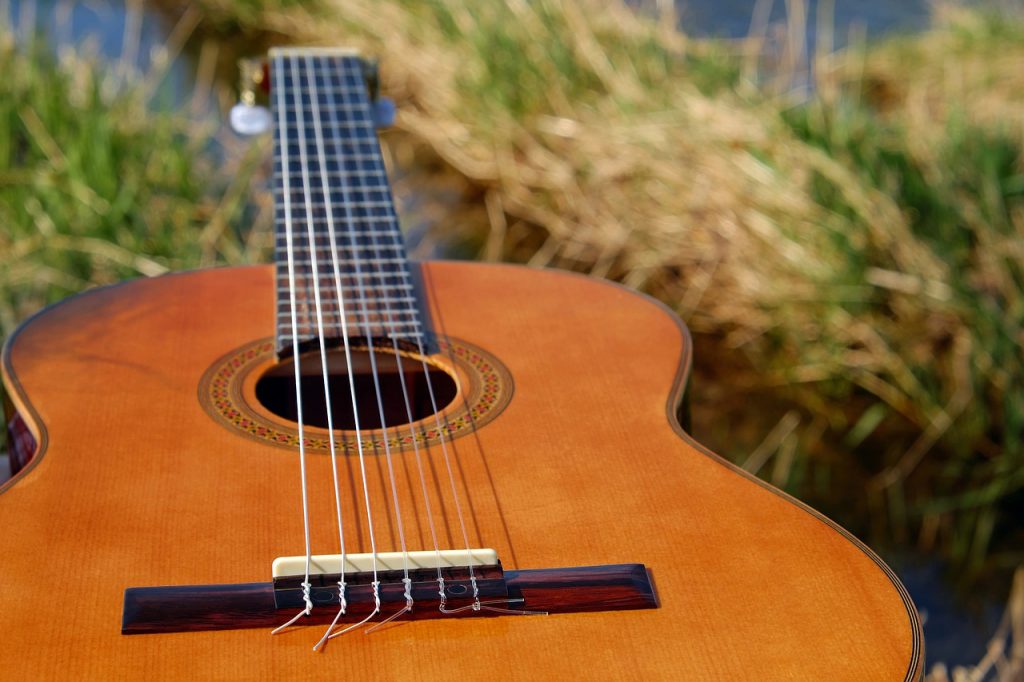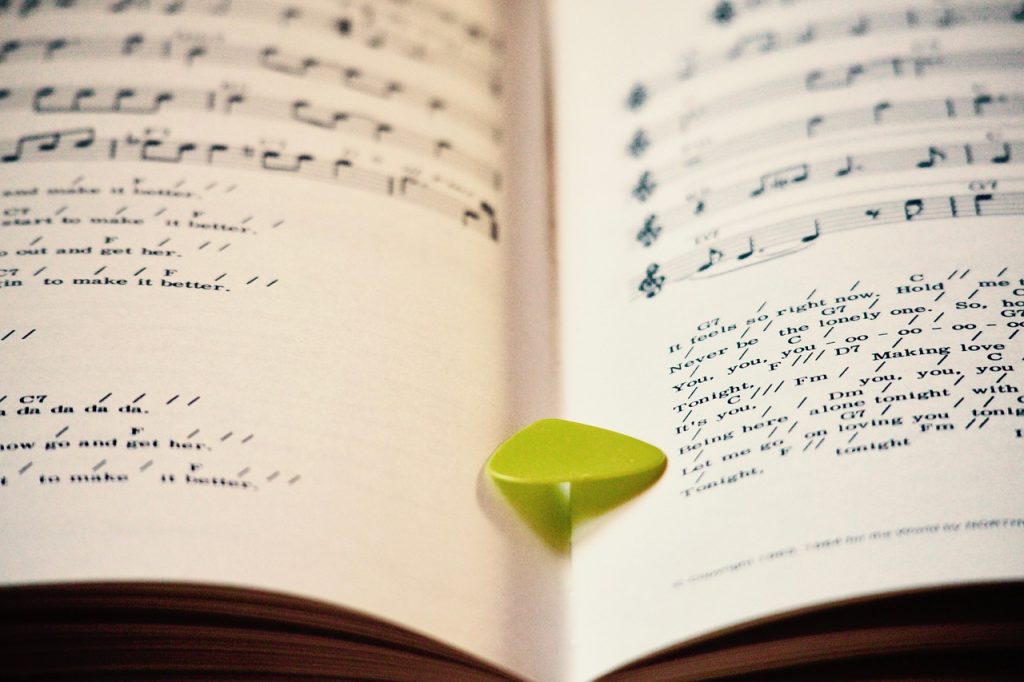Note: If you registered before 16 October 2017 and have not yet done so please reset your password. Reset
We have switched over to a new website platform which will allow us to vastly improve the service offered by The Talent Bank.
The Best Acoustic Guitars in the World

Finding the best acoustic guitar is a tricky task and of course it is subjective and dependent on what you want to do with it and your own personal taste.
The good news is if you are unsure about which instrument to buy you’re in the right place. Here at The Talent Bank, we know a thing or two about guitars so have put together this detailed rundown of the all the best acoustic guitars from beginner to pro, blues to rock and everything in between.
I play guitar myself (admittedly quite badly) so can give you the full low down on each one.
What to look for in an acoustic guitar
There are some key traits you need to look for in all guitars:
- Shape – How comfortable does it feel? Put it on your lap, wrap your chord hand around the neck and rest your other on the strings. With so many shapes and sizes, you want one that won’t feel awkward that you’ll regret as soon as you get home.
- Condition – This is obvious. Are there any cracks in the wood? Is the top face flat or depressed in or out slightly? Could you slide a pin between the base of the neck and main body? Even minor damages like this will sneak up on you down the line and is something you can avoid.
- Sound – This is, of course, the most important thing for any musical instrument, to be considered a high-quality acoustic guitar it must sound amazing and suit the type of music you want to play.
The top acoustic guitar brands
Acoustic guitars come in all shapes and sizes and the amount of choice may be overwhelming at first.
Some of the best acoustic guitars in the world are made by brands such as Gibson, Fender and Ibanez.
These brands are famous all over the world and have produced some classic models over the years but there are hundreds of manufacturers to choose from and we have reviewed the best models around at the moment to help you choose.

Here are our picks for the best acoustic guitars
Seagull S6
The Seagull S6 is your top choice for all-around quality, sound and design. It’s made of quality body woods like cedar and cherry, something that will last your hours of playing. Joining of the neck to the guitar body and a tapered fretboard provide stability even when tuning.
Features:
- Steel-string
- Quality crafting
- Dynamic sound + projection
- Wide fretboard
If aesthetics aren’t enough to win you over, it’s matched by the sound and ease of playing. The quality of the woods brings an even, dynamic projection of mid-range sound.
What’s more, it boasts a slightly wider than normal fretboard, so if you’re used to manic manipulation with your fingers, this will fit well into your hands.
A little further up the price range, but if you have the investment it will last you well into your playing years. A well-rounded model in quality, sound & looks and without doubt one of the best acoustic guitars on the market.
Jasmine Natural S-35
Jasmine is a great beginners model, being not too complicated to pick up without sacrificing the essentials you look for in a guitar. The Jasmine Natural boasts a ‘Man of War’ style, the effect being a strong, gutsy sound that shows clear presence when you are in the room.
Features:
- Strong durable construction
- Simple & straightforward playing
- ‘Man of war’ style
- Deep sound projection
The wood finish on this one is very fine, and also adds to sound boosting reverberation for that added sound effect.
The guitar is durable, lasting without over-complicating the layout, meaning you’ll pick it up in no time and not want to stop! If you are a beginner looking for something you can quickly learn on with that added ‘boom’, the Jasmines’ combination of design, assembly and projection will not let you down.
Yamaha FG830
Yamaha’s FG830 is by no means a new release, but fifty years on the market as guitar players’ favorite is a testament to the quality you’ll expect. The design boasts a solid spruce top, and rosewood back, sides and fretboard.
Features:
- Longevity expected from a trustable brand
- Quality construction
- Perfect mix of aesthetics & comfort
- Very reasonable price
- High sound definition
The Sound quality is stunning at this price range, providing excellent projection, plenty of range and tone with a dynamic finish.
If that’s not enough, it’s a comfortable model for extra long easy playing and makes sessions a dream to play.
Advanced scallop bracing not only builds upon this sound even more but also adds to a solid construction giving you the durability you’ll love in such an enjoyable model to play.
Most models of this well-balanced quality take a bite out of your budget so at its modest price range if you are looking for a brilliant all-rounder this is a must-have guitar.
Fender Tim Armstrong Hellcat 300
Fender is a brand well known for quality, and the Armstrong Hellcat is no exception. Looking for an affordable well-rounded guitar that will stay true to your punk roots? Then this is one for your wish list!
It has that quality scallop bracing of the Yamaha and a fine mahogany construction, something that won’t let you down.
This may not seem very ‘punk, but that’s until you get to the neck – you’ll find a double skull and Hellcat inlay on the fretboard and the headstock even has Tim Armstrong’s signature.
Features:
- Distinct ‘attitude’
- Solid mahogany finish
- Stunning design
- Great sound at price range
If the looks weren’t enough, the sound on this one still holds a decent punch, amped up to a Fishman Isys III pickup system inbuilt. All at a very pleasing price – for something that is nothing short of a legend, you certainly get your money’s worth. A must for any punk fanatic!
Best acoustic guitars for beginners
What kind of acoustic guitar do you want as a beginner for the best learning experience? Choose something that will be comfortable to play, and allow hours of playing as you pick up the basics. These are our top two recommendations:
Bristol by Blueridge BD16
The Bristol by Blueridge design is sturdy, durable and well-crafted with a nice aesthetic finish. Strong mahogany body and neck with a spruce top gives you the strength you want without being too weighty. The slim mahogany neck supports fast learning for any style.
Features:
- Affordable first model
- Strong mahogany construction
- Bright, easy sound
- Comfortable playing
The combination of woods from the Bristol produces a fine even projection, full sounding and pleasing to the ear of a first-time learner. At the same time, it sits comfortably in your hands and allows you to sit for hours trying new notes, picking up tunes and just spending time getting used to.
At such an attractive price range, it’s a great choice for all beginner guitarists.
Washburn WD25S
A simple yet elegant style matches up with an affordable price range to create something that will look and feel good without creating a hole in your wallet.
Solid spruce and rosewood construction combine durability with an elegant finish. When you’re starting out, you certainly want something that will last so this will work in your favor.
Features:
- Warm, deep sound
- Excellent projection
- Suitable for all styles
- Beautiful construction
- Affordable price label
A large spacious dreadnought-style body provides excellent projection with warmth and vigor, a sound you’ll certainly get used to. It has a broad yet dynamic range that’s suitable for any style as you explore the ones you are most drawn to. Whatever your passion for playing starts out as, this fine quality, elegant yet affordable model will take you well on the way.
Best Cheap / affordable options
Guitar buying on a budget needn’t be difficult. The main thing to look out for is that you’re getting value and not a poorly made guitar – the good news is you can pick up some awesome guitars on a budget, here are a couple of real bargains to look at for:
Yamaha FG700S Solid Top Dreadnought
By now you should be warmed up to the fine reputation of Yamaha instruments, and this one certainly holds true to the name. The FG700S is a popular starter model, as you’ve got quality and sound without paying a hefty price. Solid spruce supports the top, with nato back and sides, a durability you can trust.
Features:
- Solid construction
- Excellent sound
- Durable quality
- Popular beginner model
At the same time, you’ve got a nice even sound, warm and full of body. The FG700S boasts many of the qualities you’d expect from a more expensive guitar which makes it one of the best acoustic guitars if you are ona tight budget.
Epiphone DR-100 Acoustic Guitar
Epiphany again has a reputation for affordable quality. Those accustomed to the guitars will recognize the signature ‘E’ sticker on the front, this time sitting atop a fine mahogany body with a spruce top.
Features:
- Strong wood construction
- Full bodied sound
- Large dreadnought style
- Great choice for beginners
The combination of the woods above creates a fine, bright sound you’ll certainly enjoy through hours of playing. If you’ve got a bit more to spend you can get an ebony or vintage finish but the natural boasts all the benefits of sound and construction without being too costly.
Best looking options
When money is not an issue and you just want something that looks AMAZING and is generally a great product, which one do you go for? Try these two beasts on for size:
Luna Fauna Phoenix
Luna is widely known as one of the best for aesthetics, and with this one, you know why. A sheet black color finish sits underneath the incredible Phoenix design. Dancing down the fretboard are your various phases of the moon atop a fine wood background.
Features:
- Black with stunning phoenix design
- Electro and acoustic both deliver brilliant sound
- Ideal for country
Luna doesn’t spare any expense on the sound though, and the Phoenix certainly packs a punch. Whether plugged in or using it as a classic acoustic you get a bright, full sound. Ideal guitar for any country fan, but works well for other styles as well. This is truly one of the most handsome acoustic guitars in existence.
Fender CD-60 Dreadnought
Another brilliant model from Fender, this time the perfect harmony of looks and effect. The stunningly well-built mahogany body echoes roots of classic guitar, with a strong slim mahogany neck, making it durable as well.
Features:
- Strong wood build
- Classic mahogany finish
- Ideal for beginners
- Comfortable price label
Sound quality is simple but beautiful, an ideal pick for new players. What’s more, it carries a much more tempting price label. With so much value jammed in, you’d be mad to refuse.
Best sounding acoustic guitars
If a high-quality sound or a guitar suitable for recording is more what you’re looking for, there are a few which will surrender to none. These are the best acoustic guitars in terms of sound:
Bourgeois BK/Slope D
Bourgeois have always been at the top of the game, and with this awesome guitar they live up to that reputation. Strong spruce knitted with mahogany and a classic wood finish gives you a beautiful visual that will last you through the years – something you want at this end of the market.
Features:
- Strong combination of spruce & mahogany
- Big on volume
- High-quality sound throughout the pitch range
- Sheer presence with chord playing
Now onto the sound. The BK is a big number throughout the range. You want to pay attention most to the high and low though. At the bass end, it’s meaty and booming, while high notes are deliciously velvety. What it does pack is a punch, making it ideal for chord playing.
Gibson J-200 Standard
The Gibson J-200 Standard is the king when it comes to versatility. This starts with a flamed maple back with Sitka Spruce soundboard and has options for both electro and classic acoustic.
Features:
- Electro-acoustic
- Plays almost any type of music
- An icon of high-end guitars
Sound quality is epic; with a range you can rarely find elsewhere. The super jumbo body boasts serious volume, which sounds better the more it ages. Most of all, it suits any type of guitarist being ideal for blues, country and almost any style. The rich sound it can create makes it a must try for any serious guitarist.
Different guitars suit different types of music
By now you will be well aware that each guitar sings its own unique praises. Particular models can also work best for certain styles.
Once you have found your feet and warm to a style of music true to your heart, you will be looking for a companion next that lives up to that.
Whether you’re playing for your profession or just for sheer passion, one that does justice to your style will be worth the investment. Here are our best acoustic guitars in terms of rock, blues and country to get you going.
Best acoustic guitars for playing the blues:
Martin 000-15M
Martin is known as an icon in acoustics, with blues being where they really bring out the emotion. This model gives you that added touch of flair and magic. The body is the finest mahogany, and while it’s by no means cheap, it will certainly last. Strong steel strings are a hard burden to bear, but with this quality, worth it.
Features:
- Steel string
- High-end quality
- Warm yet emotive sound
The finish is warm and moody, something that’ thankfully echoed by its sound. The Martin 000-15M has a powerful tone, particularly at the mid-range, conjuring up the deepest of feelings. If you’re looking for the best, you won’t be disappointed this is perfect for the serious blues loving musicians.
Best for rock songs:
Collings D1
First, let’s start with aesthetics. The wood finish on this one is very pleasing, with a square shoulder leading into a large dreadnought body. Back, sides and neck are all Honduran mahogany, and with a spruce top, you have a perfect mix of looks and rock star cool!
Features:
- Large body
- Powerful volume
- Strong mahogany spruce combination
The sound is typical of a guitar of this size; big and booming, giving that presence toy need. As such it keeps up with not just vocals but also stronger instruments like banjos and fiddles. With a silky smooth playability, this is one that will do justice to your classic rock anthems.
Best for children / people with small hands
Finally, we look into our scaled down models – whether you’re a junior rising the ranks or just find the full versions cumbersome, you want one you’ll be comfortable playing. Here are our picks for the best acoustic guitars for children:
Yamaha JR1 ¾ Acoustic
A fine model to carry the Yamaha brand scaled down but still packing a punch. The JR1 combines quality body woods and works much like a smaller FG series. The comfortable price label makes it one of the best acustic guitars for a child to learn on.
Features:
- Great starter
- Easy to travel
- Bright full sound
The sound is bright and consistent, giving plenty of oomph despite the size. It also travels well and is an ideal companion to take on your holiday. Whatever your needs, if you are looking for a smaller guitar you’re sure to be satisfied.
Taylor GS Mini
This model from Taylor Guitars is something you’ll really enjoy playing. The design is on the verge of pristine. As with the Seagull, we featured above, steel strings mean you may want to get used to playing first for fear of discouragement.
Once you are at the stage, you will certainly be rewarded though! The Mini 300 bears true to its name with a scaled down Grand Symphony Sapele body of quality wood construction. The fretboard too is strong, comfortable and attractive.
Features:
- Grandeur & prestige of scaled-down Sapele body
- High-quality wood construction
- Steel string
- Comfortable neck to play on
- Compact & easy to transport
Its design leaves room for plenty of resonation, creating a warm dynamic sound. If you are used to taking your guitar on the road, this is the perfect choice for you being compact and easily transportable. All without compromising on sound and durability. A fine choice for anyone from beginner to intermediate
With so many choices, the key is to find the best acoustic guitar for your needs. A combination of strong woods, a pleasing aesthetic and sound to match your style can never do you wrong.
As you begin to build a few hours and expertise you can invest in more of a keepsake, but whatever your budget or experience, there are plenty of well-balanced models out there without breaking the bank.
Learning to Play the Guitar
There are many ways you can get started learning the guitar, you can get lessons or teach yourself. If you choose the latter then video guides are a great way to start:
Useful Resources for Playing Guitar
If you’re seriously interested in learning how to play acoustic guitar, there are a variety of online resources for beginners you can explore to get started.
- Music Radar – A fantastic website and YouTube channel with comprehensive tips and lessons for budding guitar players in a range of genres, including rock, blues, pop, country, and classical. Particularly popular for rock music fanatics, Music Radar has a variety of renowned rock guitar players that contribute tips to its website regularly. If you’re not sure which guitar or guitar accessories to purchase, Music Radar has you covered with regular gear reviews from the likes of Frank Turner and more.
- Dolphin Street – The only tool you’ll need to learn the basics of playing the guitar, Dolphin Street is a popular website and YouTube channel that offers expert insight into techniques and tips, as well as in-video gear reviews where you’ll have the chance to compare the sound of different amps and guitars, for instance.
- ArtistWorks – Offering a comprehensive range of interactive online beginner guitar lessons, ArtistWorks is a free educational tool that will teach you not only how to play the acoustic guitar but also a range of popular songs and insightful information about acoustic guitars and how the different components affect play.
- National Guitar Academy – Founded by guitar enthusiast Mike Kennedy, the National Guitar Academy are a one-stop shop for everything you need to know about acoustic guitars. National Guitar Academy has a great email newsletter sharing guitar tips and tutorials multiple times a week and it’s How to Play Acoustic Guitar guide for beginners is a superb place to start, teaching you everything from posture when playing to easy chords and understanding notes and sound.
- GuitarJamz – If you are an absolute beginner, YouTube channel GuitarJamz is the perfect place to learn the basics of playing acoustic guitar in just minutes, including the different notes, chords, and even basic songs to get you started.
- Guitar World – If you’re seeking a more thorough look at guitars as well as great acoustic guitar reviews, Guitar World is a brilliant website that not only has the latest guitar news but also regularly speaks to world-renowned guitarists, helping to keep the inspiration flowing.
- Registry of Guitar Tutors – If you’re looking to find a local guitar tutor in your area, refer to the RGT at London College of Music to find a qualified teacher.
- Guitar lessons: http://www.guitarlessons.com/guitar-lessons/beginner-guitar-quick-start-series/learn-how-to-play-guitar/
- Guitar tab: https://www.ultimate-guitar.com/
- Guitar chords: https://truefire.com/guitar-chord-charts/
- You can use electronic guitar tuners or learn to tune by ear: https://www.proguitar.com/academy/guitar/how-to-tune/by-ear
The history of the acoustic guitar
The acoustic guitar we know today is typically considered to be of European origin and was first used during the Renaissance and Baroque periods – in 1680, the original traditional four-string guitar was adapted by Antonio Stradivarius and a five-string guitar was born.
Just over 150 years later, in the 1830s, George Louis Panormo created the six-string acoustic guitar which was then tweaked by Spanish guitar maker Antonio Torres Jurado in 1859, creating the now classic acoustic guitar shape.
Despite the development of the acoustic guitar in Europe in recent years, variations of the now classic design have been found in the Far East dating back thousands of years, proving that the unique sound of the acoustic guitar is one that has been favored for centuries across the world and in numerous cultures.
If you’re interested in the history of the acoustic guitar, listen to the work of Brazilian guitarist Baden Powell de Aquino, influential bluesman Robert Johnson and classical guitar player Andrés Segovia
Choosing the right strings
Even the best acoustic guitars are nothing without good strings. Unlike electric guitars you don’t rely on tech to amplify the sound of an acoustic guitar, the strings you choose have a much bigger influence on the sound of your acoustic guitar.
When choosing the strings for your acoustic guitar, you should keep the body of the guitar and the sound you’re aiming for in mind.

Check whether you have an Acoustic or Classical Guitar
To prevent damage to your guitar, it’s essential that you check whether your guitar is an acoustic guitar or a classical flamenco guitar.
Classic flamenco guitars are fitted with nylon strings while acoustic guitars have steel strings – the type of strings on your guitar will alter the sound extensively and you can easily hear the difference in.
Typically, classical flamenco guitars are slightly higher in pitch while acoustic guitars will give off a similar sound found in blues, rock, and country music.
Steel guitar strings require more tension than nylon strings which is one reason you need to ensure you don’t mix up the type of guitar you have – by doing so, you could damage the construction and brace on your guitar.
Using the wrong strings could also damage the bridge and even the body of your guitar. Whether or not you have a cutaway guitar will also influence the sound.
Find out more about the differences between classical and acoustic guitars.
Light Gauge Strings vs Heavy Gauge Strings
Guitar strings come in a range of gauges, or thicknesses, and the thickness of your guitar strings will affect the resulting sound. Gauge is measured in thousandths of an inch – the lightest gauge available is 0.010 while the heaviest is 0.059 – the title of the string gauge is also a good measure to determine the type of sound the gauge creates. Heavier gauge strings create a heavier sound with a lot of bass while lighter gauge strings have a very light, upbeat sound for a somewhat brighter undertone.
Strings with lighter gauges are admired for their ease of play as well as the sound adaptability they offer, allowing you to bend notes easily. However, due to their thinness, low gauge strings are quieter when played and are also easier to break, which means you will almost definitely go through more than if you were to choose heavier gauge strings – this is something to keep in mind if you’re a beginner guitarist as strings can be expensive so you don’t want to have to replace them too often.
If you’re a professional musician with plenty of experience playing acoustic guitar, you may want to choose heavier gauge strings. Heavier varieties of string are more difficult to play as they require more pressure than lighter gauge strings, however, with their difficulty comes an improved sound level that’s not only louder but also sustained for longer – perfect if you’re looking to play rock music
Generally, it is recommended that you string a smaller acoustic guitar with lighter gauge strings and larger guitars with heavier gauge strings. However, if the music you are playing requires lots of strumming, you should opt for a medium gauge string to get the best sound quality and reduce the chance of your strings breaking. String tension will also affect the sound of your acoustic guitar. To find out more about string tension and the best tension for your guitar, see D’Addario’s guide.
How the material of the strings affects the sound
Different types of strings will affect the sound when playing your guitar. When choosing new acoustic guitar strings, think about the sound you’re aiming to create and consider the following types of strings:
- Silk and Steel – Very popular in country music, silk and steel strings produce a very delicate sound with definition.
- Brass – Metallic in sound, brass strings are ideal for uplifting music.
- Bronze – There are three types of bronze strings: bronze, phosphor bronze, and aluminum bronze. Classic bronze strings have a very clear, upbeat sound but a short lifespan while phosphor bronze strings are somewhat long-lasting and produce a warm, dark sound. Aluminum bronze strings have more bass and produce a crisper sound.
- Polymer-coated – Long lasting and available in a variety of colors, polymer-coated strings sustain a bright sound and are particularly popular in rock/pop music.
If you’re looking to create a unique sound for yourself, it’s always recommended that you experiment with a variety of different styles of string to find the one that works best for you.
For a comprehensive guide to buying acoustic guitar strings, refer to Guitar World.
Nylon String Guitars
If you are looking to play flamenco, folk, or classical music, you will need to own a nylon string guitar. Nylon strings are also a fantastic choice if you’re a beginner guitar player as, typically, they are easier to play. However, nylon string guitars require tuning more frequently than steel string guitars so it’s important to keep an ear out when playing to ensure your sound isn’t off.
When playing a nylon string guitar, it is the string tension that will affect the sound to the greatest extent. If you opt for a moderate tension, your guitar will project the sound less and produce a much smoother sound, however, that sound may be subject to buzzing. If you need more sound in your play, try a higher tension – especially useful if your music is defined and rhythmic.
For a comprehensive guide to nylon string guitars to become a master of the fingerboard, refer to Music Radar.
Should you use a plectrum or fingers
In most instances, whether you use a pick to play your guitar is down to preference, however, the choice between a pick and fingers can also influence the sound of your guitar.

When you’re learning to play the guitar, some experts say that it’s best to use your fingers as it will better help you to understand chords and get your guitar playing skills spot on. However, playing with your fingers will provide you with a much warmer sound than playing with a pick as, generally, the strumming of the strings is less brash and, thanks to the skin on your fingers, is mellowed.
You can change the tone by plucking with both your fingers and your fingernails, however, you should grow your nails before doing so to ensure you don’t damage your fingertips. Fingerpicking is particularly popular with those playing soft blues music or pop music where a softer tone is preferred.
Playing the guitar with a plectrum, or a pick is typical of heavier music such as rock where you may be required to strum the strings harder which if done without a pick would quickly damage the tips of your fingers, leaving you unable to play – or playing in pain.
When performing, strumming your guitar with a pick is a great way to produce a louder sound that projects right to the back of the venue. There are also several pick techniques you can use when playing the guitar to adapt your sound, including downstroke picking, alternate picking, sweep picking, and hybrid picking.
Find out more about the different types of pick techniques via Guitar Habits.
Difference between an acoustic and an electro-acoustic
Due to their versatility, more people than ever are choosing to play electro-acoustic, or semi-acoustic, guitars rather than classic acoustic guitars.
While classic acoustic guitars rely solely on the space in the body of the guitar to reflect the sound being created by the strings, electro-acoustic guitars allow you to plug your guitar into an amp to further project the sound, just like an electric guitar. When it comes to buying a guitar, many face the trials and tribulations of choosing between an acoustic guitar and electric guitar, however, an electro-acoustic guitar lets you have the best of both worlds.
Typically, classic acoustic guitars are used to play softer music with a warmer feel, however, electro-acoustic guitars allow you to play soft music while giving you a choice to increase the tempo should you wish by using an amp. Music Radar has a superb guide to the best electro-acoustic guitar amps.
Electro-acoustic guitars are considered particularly useful if you’re playing on stage as they allow you to control the sound you’re producing with more than just your fingers, helping to project the sound to the back of the room so you don’t have any disappointed fans and, better still, can be heard in equal amounts as your other bandmates. Plus, if you are playing a classic acoustic guitar, you will usually have to stay by the mic so none of the sound is lost, however, with an electro-acoustic guitar, you can move around the stage without losing sound quality.
If you’re looking for a more seamless sound, an electro-acoustic guitar with a built-in equalizer and tuner could be a fantastic option as both features will adjust your tone on output to keep everything sounding top-notch without the hassle of re-tuning before or, worse still, in the middle of a set.


 How to Write Poetry For Beginners: Easy if You Know How
How to Write Poetry For Beginners: Easy if You Know How The Best Acoustic Guitars in the World
The Best Acoustic Guitars in the World 9 Super Creative Street Art Pieces
9 Super Creative Street Art Pieces The 10 Greatest TV Shows of All Time
The 10 Greatest TV Shows of All Time
Great!Thanks for the post. It will be very helpful if you write about electric guitar